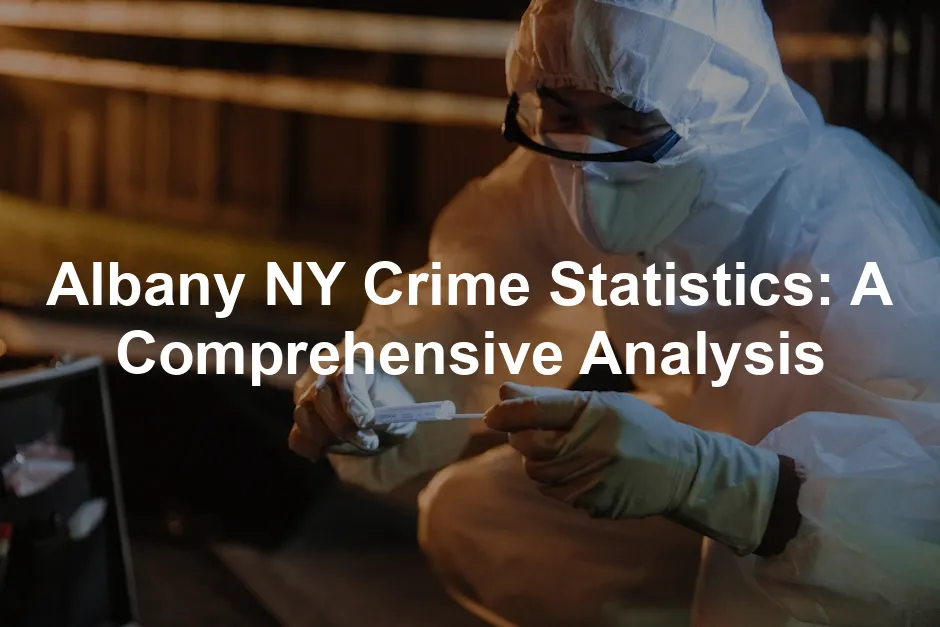Introduction
Albany, NY, stands tall as the capital of New York State. This vibrant city is rich in history and culture, attracting residents and visitors alike. However, like many urban areas, Albany faces its share of challenges, particularly regarding crime.
Crime statistics serve as essential tools for understanding safety within a community. They provide insights into the types of offenses occurring, allowing residents, visitors, and policymakers to make informed decisions. By examining these statistics, individuals can assess the safety of neighborhoods, the effectiveness of law enforcement, and the resources needed for community improvement.
This article aims to offer a detailed analysis of crime statistics in Albany. We will explore current trends, compare figures to state and national averages, and uncover neighborhood-specific insights. Whether you’re a potential visitor or a long-time resident, understanding these statistics is vital for navigating Albany safely.
To enhance your personal safety, consider investing in a Home Security System. With the crime rates being what they are, having a reliable security system can provide peace of mind, allowing you to focus on enjoying life in Albany rather than worrying about break-ins.
Understanding Albany’s Crime Statistics
Overview of Crime Statistics
Crime statistics encompass a range of offenses, categorized mainly into violent and property crimes. Violent crimes include serious offenses such as murder, rape, robbery, and assault. In contrast, property crimes cover burglary, theft, and motor vehicle theft. Understanding these categories helps residents gauge the safety of their neighborhoods and make informed decisions regarding personal safety.
Access to crime statistics fosters community engagement. When residents are aware of crime trends, they can advocate for resources and support to improve safety measures. This knowledge empowers communities to work collaboratively with law enforcement to address concerns effectively.
One way to bolster your safety is by carrying personal protection items such as a Personal Safety Alarm. These handy devices can emit loud sounds to deter potential threats and alert others in case of danger. Staying safe in Albany is all about being prepared!
Latest Crime Data
In 2022, Albany reported an overall crime rate of 46 per 1,000 residents. This figure indicates a higher-than-average risk of becoming a victim of crime, as residents face a 1 in 22 chance of encountering criminal activity. These statistics, sourced from the FBI and local law enforcement agencies, reflect a city grappling with safety concerns.
Violent crime rates in Albany stand at 9.18 per 1,000 residents, with a total of 926 incidents reported. Out of these, 11 were classified as murders, while 68 were rapes, and 232 were robberies. Assaults make up the bulk of violent crimes, totaling 615 incidents. On the property crime side, Albany’s rate is 37.08 per 1,000 residents, with 3,739 total property crimes reported, including 531 burglaries, 2,651 thefts, and 557 motor vehicle thefts.
Understanding these numbers is crucial for anyone living in or visiting Albany. By familiarizing themselves with the latest crime data, individuals can take proactive steps to ensure their safety while navigating the city. Consider having a Pepper Spray handy; it’s a compact self-defense tool that can provide an extra layer of security when you’re out and about.

Breakdown of Violent Crimes in Albany
Types of Violent Crimes
Murder
Murder in Albany is a serious concern. In 2022, Albany recorded 11 murders, which, while tragic, reflects stability compared to years past. For instance, in 2020, the city saw 16 murders, marking a troubling spike. The murder rate in Albany stands at 11.2 per 100,000 residents, significantly higher than the national average of 6.3. This increase can be attributed to various factors including socioeconomic challenges and urban dynamics.
Rape
Rape remains another pressing issue. In 2022, there were 68 reported incidents of rape. This statistic represents a slight increase from previous years, hinting at ongoing societal problems. When looking at the national average of 40.0 rapes per 100,000 residents, Albany’s rate of 61.2 indicates a community grappling with this serious crime. The rise in reporting could also reflect growing awareness and willingness to report such crimes, which is a hopeful sign.
Robbery and Assault
Robbery and assault are the most frequent violent crimes in Albany. With 232 robberies and 615 assaults reported in 2022, these figures paint a concerning picture of community safety. The robbery rate of 234.4 per 100,000 residents is nearly double the national average of 66.1. Assaults, often linked to personal conflicts or drug-related issues, have a rate of 611 per 100,000, significantly surpassing the national average of 268.2. These numbers highlight the urgent need for community programs aimed at conflict resolution and crime prevention.
To equip yourself for unexpected situations, consider investing in a Self-Defense Keychain. These compact tools can provide a sense of security without being too bulky, making them perfect for daily carry.
Comparisons with State and National Averages
When comparing Albany’s violent crime rate to the state and national averages, the disparities are stark. Albany’s violent crime rate of 9.18 per 1,000 residents is substantially higher than New York State’s rate of 4.29, and the national median of 4.0. This data suggests that Albany faces unique challenges that contribute to its elevated crime rates. The high rates can deter potential residents and visitors, raising questions about the effectiveness of local law enforcement and community safety measures. These comparisons reveal that while Albany has its strengths, addressing the roots of violent crime is critical for improving its safety reputation.

Breakdown of Property Crimes in Albany
Types of Property Crimes
Burglary
Burglary is a significant property crime in Albany, with 531 reported incidents in 2022. This translates to a burglary rate of 539.2 per 100,000 residents, which is above the national average of 500.1. Popular locations for these crimes tend to be residential areas with less security, making it essential for homeowners to invest in preventive measures like Outdoor Motion Sensor Lights and neighborhood watch programs.
Theft and Motor Vehicle Theft
Theft remains the most prevalent property crime, with 2,651 incidents recorded. This startling number gives Albany a theft rate of 2,676.8 per 100,000 residents—well above the national average of 2,042.8. Motor vehicle theft, too, is a rising concern, with 557 reported cases, resulting in a rate of 555.7 per 100,000 residents compared to the national average of 284. These numbers highlight the need for increased vigilance and community engagement in crime prevention strategies.
For those with vehicles, investing in a quality Bicycle Lock can deter thieves. Remember, a little prevention can go a long way!

The concentration of these crimes indicates hotspots that local law enforcement should prioritize. Areas close to downtown and those with high foot traffic are often targeted. Community members are encouraged to report suspicious behavior and work together to enhance safety.
Overall, the statistics reveal a pressing need for comprehensive strategies to address both violent and property crimes in Albany. By focusing on community engagement, preventive measures, and enhanced law enforcement visibility, residents can work together to foster a safer environment for everyone. A Security Camera System can also be an excellent deterrent against property crimes.

Neighborhood Crime Rates and Safety
High-Crime vs. Low-Crime Neighborhoods
Albany’s crime scene is a bit like a game of hide and seek, but let’s just say some neighborhoods are much better at hiding than others. In the downtown areas, crime rates tend to be higher due to the hustle and bustle of city life. According to recent data, neighborhoods like the South End and West Hill report alarmingly high crime figures. Residents in these regions face significant risks, with property crimes and violent incidents popping up more frequently than you’d like.
On the flip side, if you’re looking for a cozy nook away from the crime chaos, consider neighborhoods such as Buckingham Lake-Crestwood and SUNY at Albany. These areas have shown a remarkable ability to keep crime at bay. The serene surroundings and community engagement in these neighborhoods create a safer atmosphere. Residents generally report feeling more secure here, making it ideal for families and students alike.

Community members in safer neighborhoods often participate in local watch groups, fostering a sense of camaraderie. Their proactive approach toward safety helps keep the crime rates down. It’s a testament to how a little vigilance can go a long way in creating a peaceful living environment.
Community Sentiment on Safety
Safety isn’t just about numbers; it’s about how people feel. Community polls reveal that sentiments on safety in Albany are mixed. A survey showed that 71% of residents feel “pretty safe,” despite acknowledging some safety concerns. However, 12% of respondents admitted to feeling “not safe” at all. This divide highlights the importance of addressing the underlying issues contributing to crime.
Local law enforcement plays a pivotal role in shaping community perceptions. In the same poll, nearly half of the respondents noted that while police presence is visible, responses to emergencies can be slow. This raises questions about the effectiveness of law enforcement in high-crime areas. Some residents believe that a more proactive police presence could enhance feelings of safety.

Moreover, the visibility of police patrols can act as a deterrent for potential criminals. When officers are seen walking the beat, it sends a message that the community is being watched. This visibility is crucial, especially in neighborhoods struggling with higher crime rates. Consider joining a neighborhood watch program to actively participate in enhancing safety in your area.
The call for increased engagement between law enforcement and the community is loud and clear. Residents are eager to work alongside officers to create safer streets. Regular community meetings could serve as a platform for discussing safety concerns, sharing ideas, and building trust.
In summary, Albany’s neighborhoods are a mixed bag of safety and risk. While some areas shine as safe havens, others struggle with crime. Community sentiment shows a desire for improvement and collaboration with law enforcement. By addressing these issues, Albany can move toward a safer, more secure environment for all its residents.

Factors Contributing to Crime in Albany
Socioeconomic Factors
Crime does not happen in a vacuum. It often thrives in environments where socioeconomic issues abound. In Albany, high unemployment rates and elevated poverty levels are significant contributors to crime. When people struggle to find work, desperation can lead to criminal behavior. This isn’t just a theory; numbers back it up.
Albany’s unemployment rate hovers around 4.3%, slightly lower than the national average of 4.7%. However, the economic strain caused by rising living costs can push some individuals towards illegal activities as a means of survival. Poverty, which affects a notable portion of the population, exacerbates this issue, creating a cycle that is hard to break.

The relationship between economic strain and crime rates in Albany becomes even clearer when you look at property crime statistics. With a property crime rate of 37.08 per 1,000 residents, the burden of financial hardship is evident. Every theft or burglary tells a story of desperation. As the cost of living continues to rise, more residents may feel compelled to resort to crime to make ends meet, indicating a need for economic solutions alongside law enforcement efforts.
For those interested in being proactive, an Emergency Preparedness Kit can be a lifesaver in case of unforeseen events. Being prepared goes a long way in ensuring safety for you and your loved ones.
Historical Trends
Looking back over the last decade, Albany’s crime trends reveal a mixed picture. From 2012 to 2022, overall crime rates experienced fluctuations. For instance, while property crimes surged by 40% in some years, violent crimes saw a slight decrease. However, the most recent data indicates a worrying uptick in both types of crime, making it crucial to analyze these trends closely.
In 2019, Albany reported approximately 1,077 violent crimes per 100,000 residents. By 2022, this number had decreased to 930 per 100,000, indicating a positive shift. Nevertheless, property crimes skyrocketed in the same period, suggesting that while violent crime may be on a decline, property offenses remain a concern. This duality complicates the safety narrative in Albany.

Some neighborhoods have improved significantly, while others continue to grapple with high crime rates. For example, areas like Buckingham Lake-Crestwood have become safer, while downtown zones still report higher incidents. The overall trend indicates that community efforts, combined with effective law enforcement strategies, are essential in combating crime.
As we analyze these historical trends, it becomes evident that addressing the root causes of crime is vital. It’s not just about statistics; it’s about real lives impacted daily. By fostering economic stability and community support, Albany can continue to work towards reducing crime and enhancing safety for all its residents.

Conclusion
In summary, Albany’s crime statistics reveal a complex landscape influenced by various factors. Socioeconomic challenges, including unemployment and poverty, significantly contribute to crime rates. Historical trends indicate that while some aspects of crime have improved, others remain concerning.
Community awareness and proactive measures are crucial for addressing these issues. Residents must stay informed and engaged with local efforts aimed at improving safety. Whether through neighborhood watch programs or community meetings, every little bit helps. And while you’re at it, consider picking up a Fire Extinguisher for your home to ensure you’re prepared for all emergencies!
Let’s not just be passive observers. It’s time to get involved! Join local initiatives focused on crime prevention and community safety. Together, we can make Albany a better place for everyone. The fight against crime is a shared responsibility, and every action counts.
FAQs
What is the overall crime rate in Albany, NY?
Albany, NY, has a crime rate of 46 per 1,000 residents. This stat indicates a higher-than-average risk of becoming a victim of crime, with residents facing a 1 in 22 chance of encountering criminal activity. In 2022, Albany recorded a total of 4,711 incidents per 100,000 residents, significantly surpassing national averages. The violent crime rate stands at 9.18 per 1,000 residents, while property crimes are at 37.08 per 1,000. The numbers reveal a city grappling with safety concerns, making awareness crucial for locals and visitors alike.
How does Albany’s crime rate compare to other cities?
When compared to neighboring cities, Albany’s crime rate paints a concerning picture. For instance, while Albany’s violent crime rate is 9.18, nearby Schenectady has a rate of around 8.51. In contrast, Colonie boasts a significantly lower rate of 4.29. Property crimes follow a similar trend, with Albany’s rate of 37.08 being much higher than Colonie’s 17.22. These comparisons underscore Albany’s unique challenges, emphasizing the need for community engagement and effective law enforcement strategies to improve safety.
What can residents do to stay safe in Albany?
Residents can take several steps to enhance personal safety in Albany. First, staying informed about crime trends in the area is vital. Joining neighborhood watch programs can foster a sense of community and vigilance. Additionally, investing in security measures for homes, like alarm systems and outdoor lighting, can deter potential criminals. Engaging with local law enforcement through community meetings can also help residents voice their concerns. Lastly, practicing situational awareness, like avoiding poorly lit areas at night, can help individuals stay safe while navigating the city.
Where can I find more information on crime in Albany?
For ongoing updates on crime statistics in Albany, several reputable sources are available. NeighborhoodScout provides detailed analytics and insights into crime risk for various neighborhoods. Local law enforcement websites often publish reports and safety tips for residents. Additionally, the FBI’s Crime Data Explorer offers a broader view of crime statistics across the nation. These resources can empower residents with the knowledge needed to stay informed and safe in their communities.
Please let us know what you think about our content by leaving a comment down below!
Thank you for reading till here 🙂
All images from Pexels




